Home > Product Installs & Reviews > Product Reviews > Car Accessory Reviews > Bestek 2000W Inverter Use & Review
The Bestek 2,000 watt power inverter is a great option for those in need of serious power on the go. Bestek produces a whole range of inverters in various wattages and options. Power inverters can be useful in many situations when a 110V tool is needed or desired, but only 12V power is available. This one uses alligator clamps to directly get power from the terminal posts of a car battery. It features six 50-amp fuses and three 110-120 volt outlet sockets. Other manufacturers of power inverters of this wattage often use single clamps. The Bestek 2000w inverter uses two clamps per pole. This greatly reduces the likelihood of overheating the cables.
Opening Up The Box
The Bestek 2000w inverter shipped in a sturdy box and was well protected in a styrofoam cradle. The box contained the inverter, a flashy red aluminum alloy affair nearly the size of a car battery, two sets of cables, a bag of spare fuses, and an obviously translated-to-English instruction manual. The cables use a ¼” eyelet and a metal-lined plastic knob to fasten the inverter side of the cables. The other ends have insulated brass alligator clamps that are plenty big enough to make a solid connection on the post of a battery. The unit is substantially heavy. It is rated at 9.1 lbs, but I did not weigh it. It has a decent sized ventilation fan between the cable connections. The other end plate features three 110-120v electrical sockets. The body is ribbed aluminum alloy. The sides have ventilation fins to aid with heat dissipation.
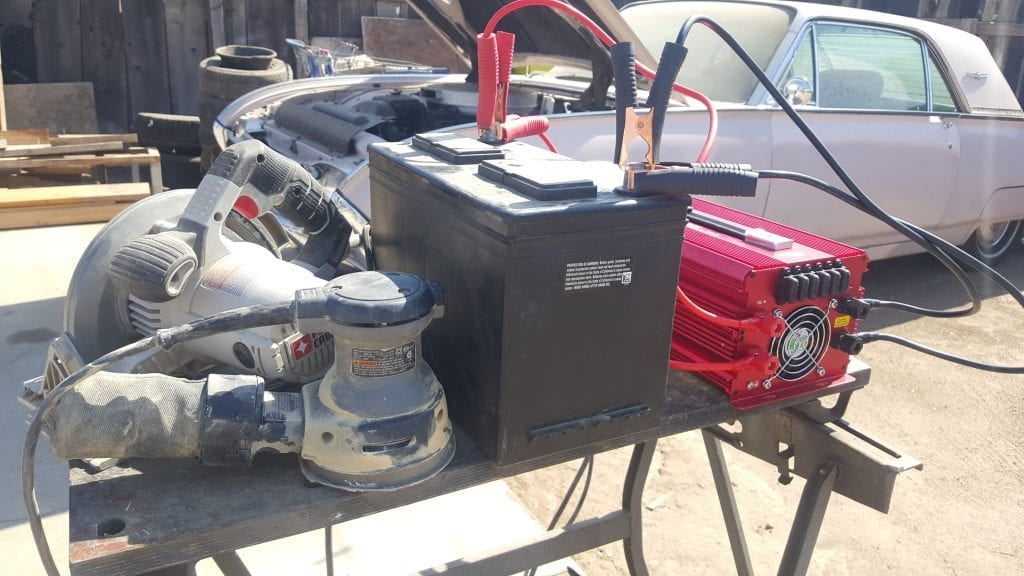
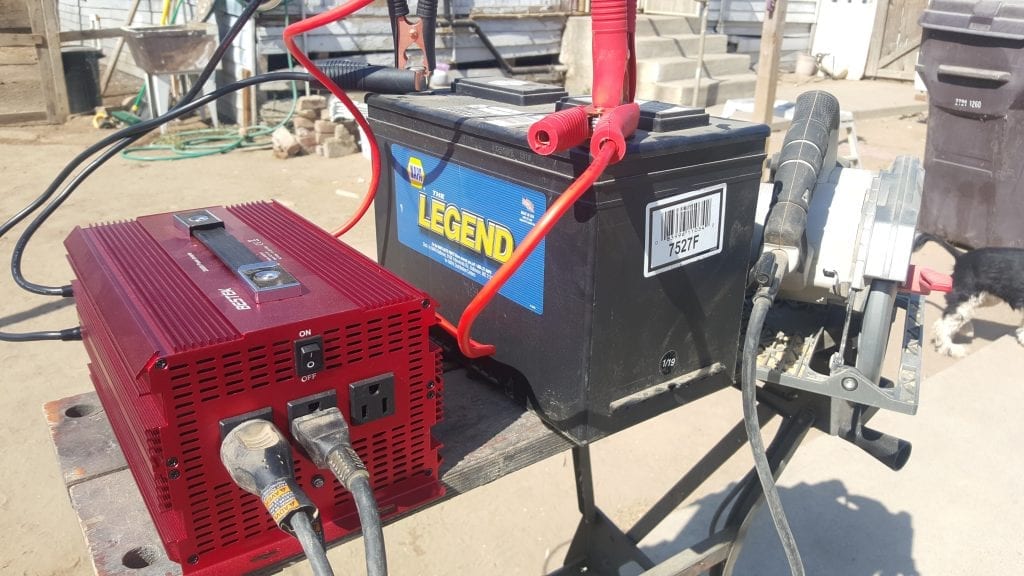
Hooking it Up, First Impressions
The dual positive and negative cables present some immediate issues. The dual clamps means both clamps must be in place for positive and negative in order for the inverter to produce maximum power. The first thing you will notice is the shortness of the cable clamps and the size of the clamps. This produces a couple problems. The alligator clamps are fairly large and will interfere with accessory cables on cluttered positive terminals. I think that using this on a side post battery would be difficult. As a safety precaution, the negative clamps should be routed to a grounded part of the car, not the negative terminal. In instances where this is not possible, ensure lots of ventilation and avoid sparks near the battery. Then, the shortness of the cables comes into play. Power inverters should always be placed on a level, solid surface. Even under the hood of my vintage Ford, I really don’t have stable and level places. The shortness of the cables meant I had to place my work table nearly against the side of my car for the leads to reach the battery and ground points. This was not ideal, but for a temporary test to ensure I had a functioning product, it worked fine. I would not want to use the power inverter this close to my car on a regular basis. Pulling the battery out and setting it on my work table made testing much more enjoyable.
The Rationale of Two, Short Cables
There is a reason the cables are short. Longer cables build more heat because of resistance to electrical current. High temperatures cause less efficiency and will eventually burn the cables. In the case of the Bestek 2000w power inverter, the cables are fairly thin at 10mm, or roughly seven gauge. Having two cables handle the work allows for better heat dissipation and a more efficient power inverter.
Using the Bestek 2000W Power Inverter
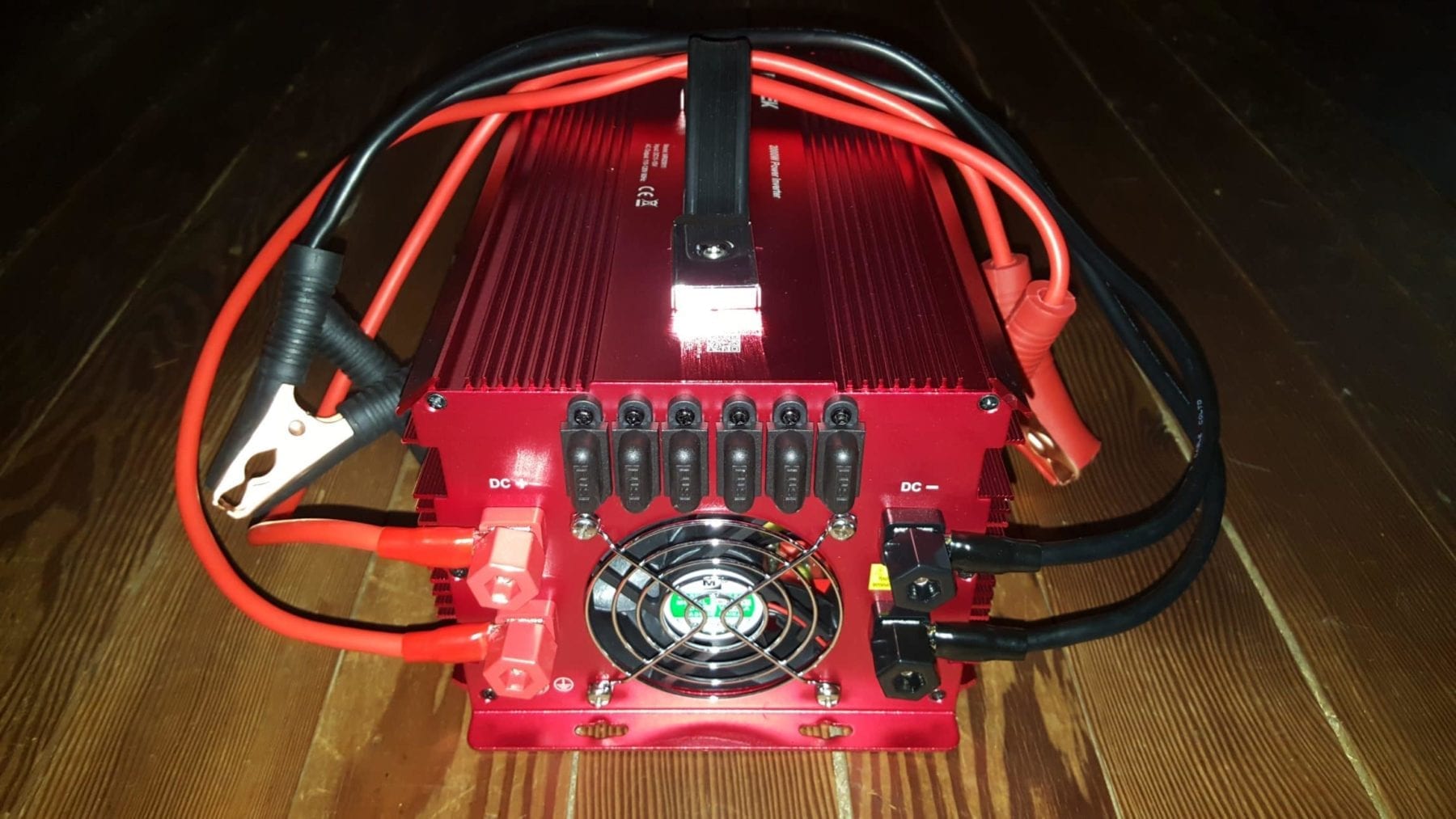
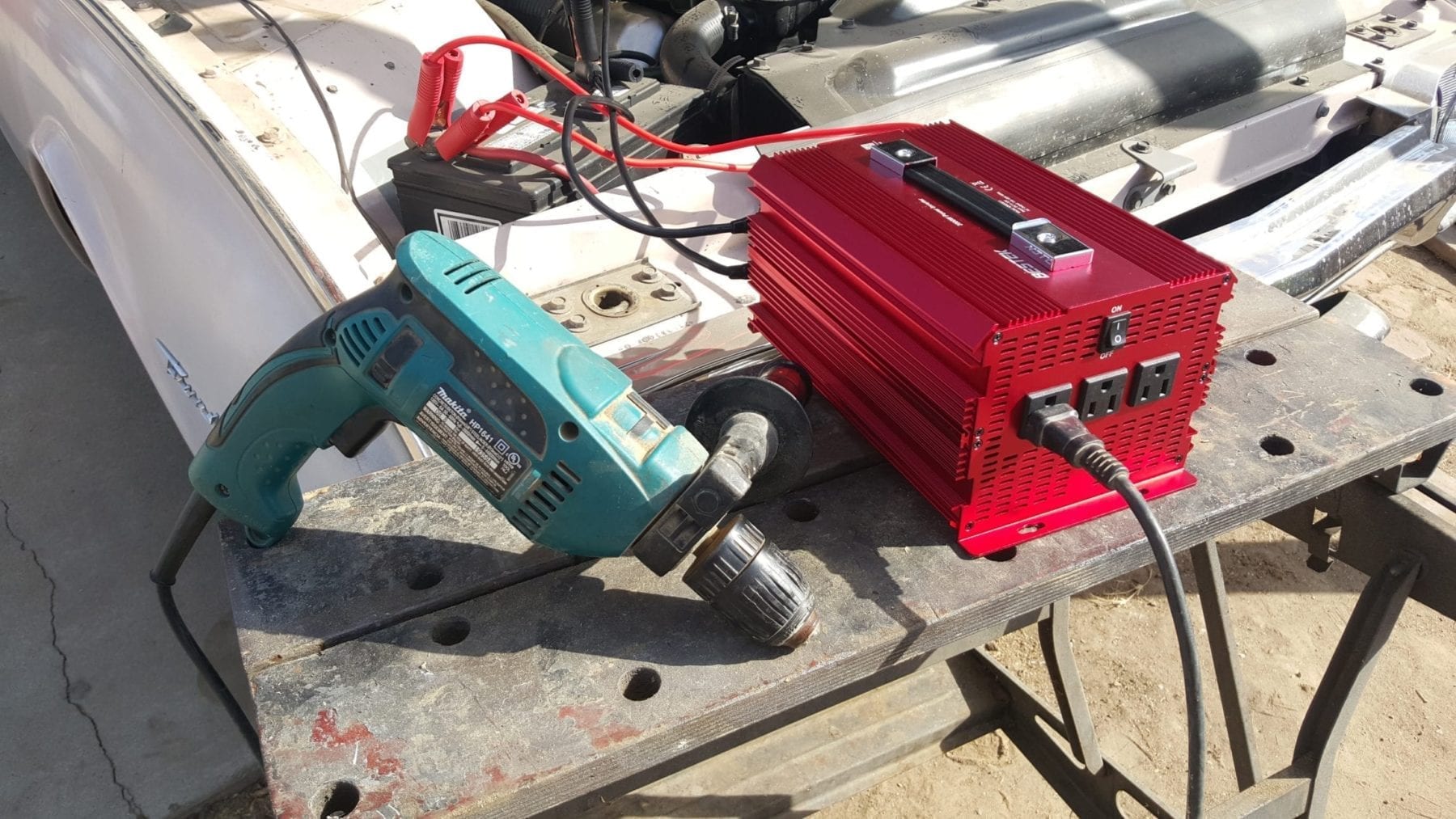
I had a 110v-6a power drill handy the first time I plugged the inverter in. Before I plugged the power drill in, I checked my battery voltage with my vehicle off. 12.56v was my initial voltage. I plugged the drill in, turned the inverter on, and punched a few holes of various sizes in a project I am working on. The inverter did what I expected and the drill worked just fine for the few minutes I used it. After running the drill for a few minutes, I tested the battery voltage again. It had dropped to 12.46v. Not a huge drop, but definitely enough to make me question just how long I could actually run a device on the inverter before the battery was dead. Voltage below 12.3 will often cause starting issues and many vehicles will not start with less than 12.1 volts.
Time for Math
Power inverters, such as this one from Bestek, are typically rated as providing power in watts. Most tools advertise power consumption in volts and amps. To find how many watts a tool uses, the math is simple. All that needs to be done is to multiply the volts by the amps. This provides watts. For more detailed information about watts, volts, and amps, see this site. What this told me is that my electric drill is using 660 watts. That means I could, in theory, run three drills simultaneously and still get power. But for how long? Rather than allow my car battery to be completely drained just to figure out how long it would work, I decided to do some calculations. The formula that is used to figure out how long a battery will last while using a power inverter can be expressed like this: (10 x [Battery Capacity] / [Load]) / 2 In the example with the drill, we can just plug in some numbers. My car battery tells me on the label that it is a 60 Amp-Hour battery. So, (10 x 60 / 660) / 2 = about 45 minutes. Running three drills simultaneously would give me about 15 minutes of actual run time until the car battery would be flatlined. This is really important to remember for people who are counting on a power inverter for medical equipment when charging a battery might be slow. It is highly recommended to use a deep-cycle battery in situations when using a power inverter for extended time periods for sensitive equipment. Deep-cycle batteries, like those found in motorhomes, typically have longer amp-hour ratings.
Bigger Batteries
A simple trick when added runtime is needed is to connect batteries up into a pack. There are two safe ways to do this. The first is called series wiring. Series wiring involves connecting batteries in series, like those Christmas light strands where one burned out bulb takes the whole strand out of commission. Series wiring batteries will double the voltage but keep the same amp-hour level, the opposite of what we want for an inverter. Series connections are made positive-to-positive and negative-to-negative. Parallel wiring will double the amp-hours while keeping the operating voltage the same. Wiring batteries in parallel is easy when done right. When done wrong, it can create explosions, fireballs, and destroy electronics. To wire batteries into a parallel circuit, simply use jumper cables to attach the positive terminal of one battery to the negative terminal of the other battery. Then, use two jumpers between the negative and positive of the other battery – one jumper for each. This will provide the same 12v power, but will give a total of 120 amp-hours. When connecting the power inverter leads, hook both leads up to the same battery. Now, I can run all three drills simultaneously for 30 minutes. That is plenty of time to screw something up!
Pure Sine Wave vs. Modified Sine Wave
AC current, what the power inverter converts 12v DC car battery power into, operates in a waveform called a sine wave. When you plug your hair dryer into the wall socket in the bathroom, you are using a pure sine wave. Power inverters like the Bestek 2000w unit I am reviewing cannot make a pure sine wave. Instead, the inverter mimics a pure sine wave, creating what is known as a modified sine wave. Inverters that make a pure sine wave are available, but tend to be two or even three times the cost of a good-quality modified sine wave inverter like the one I am reviewing from Bestek. For most applications, this won’t mean much. Many electronics will function perfectly regardless of whether AC voltage is delivered in a pure or modified wave pattern. However, some electronics are not capable of handling the additional heat that can be created when operating on a modified sine wave. Among the catastrophic stories users of power inverters have shared, one of the most common is the use of a power inverter to charge electronics like tablets, battery packs, and cell phones. In some cases, rather than a fuse blowing out, the charger or the device overheats. In some cases, this has led to meltdowns of chargers and phones. Power inverters tend to work best with devices that are resistive load rather than inductive load. Resistive load devices usually use electricity to create heat, such as an incandescent light bulb. Inductive power-using devices, like the drill I tested in the first example, are often susceptible to overheating. In the most drastic cases, reduced power will be evident, and in some cases, the windings in the motor may become overheated and melt down. In general, complex electronics, like computers, will function perfectly well on a modified sine wave. Simple items, like a battery charger either will or won’t, and you will usually know right away. Either no power will be delivered -indicating the device “senses” voltage below its threshold- or will overheat pretty quick. The Bestek 2000w power inverter I am testing produces a “stepped” modified wave, which ensures that more devices will function properly. Stepped waves are safe for brushed motors, like my drill, and will cause no problems in virtually all devices, a major selling point for this particular inverter.
Further Testing
I hooked up a really old USB charger to the inverter and connected it to an even older iPod that was fully discharged. I used an infrared thermometer to get an initial reading of 91.5 degrees, pretty much ambient air temperature on the day of testing. I plugged everything in and turned on the inverter. Immediately, the iPod displayed its “charging” screen, so I could be reasonably sure it was working. After 15 minutes, the charger measured an even 100 degrees, while the iPod had climbed to only 92 degrees. I unplugged the iPod and verified that it was charging. The battery indicator showed about ⅓ charge. Testing this charger showed no change in my car battery voltage.
Bigger Testing
High-torque motors are among the more challenging appliance power draws for 12v power inverters to run. I happened to have a really old and neglected evaporative cooler handy in my workshop. I have never verified that this ¼ hp motor actually works. It is rated as 115v and 5.8a. This would give me a wattage need of 667w, plenty below the power inverters threshold. Unfortunately, for this test, the motor would only briefly turn before stopping and only the first time that I switched it to fan mode. Turning off then turning back on the power inverter allowed one more, short rotation of the motor before it would no longer turn. My guess is the motor has an issue. It is heavily corroded and hasn’t been in use for many years. Over the next several hours, I ran a palm sander, a reciprocating saw, a circular saw, and a shop vac, all without any indication of power loss or overheating. At the end of my project, my car battery registered 12.32v and immediately started the 390 cubic inch V8 in my Ford.
What Bestek Has to Say
The Bestek 2000w Power Inverter powers household motors including 1hp pool pumps and AC units. Specifications:
- Rated Power: 2000W, Max Power: 2300W
- Peak Power: 4600W
- Input: DC 12V (12V Car or Boat but not 24V)
- Output: AC 110V-120V
- Outlets: 3 AC
- Weight: 10lb
- Fuses: 6 external 50amp fuses
Conclusions
The Bestek 2000w Power Inverter with three AC outlets performed for me flawlessly throughout testing. I attempted to put it through as much real-world testing as I could find, and I was only limited by how far I wanted to carry my car battery. I intend to hook up a solar charger and mount this inverter to a cart with a dedicated battery. This will allow me to work on various projects without the massive irritation of really long extension cords. For me, this is the perfect inverter. It provides way more power than I typically use in a convenient package. The carry strap is a nice feature and makes moving the nearly 10 lb. unit around much more comfortable. I was disappointed that the old motor I tried to start failed, but I am confident the Bestek 2000w power inverter was not the cause of the failure to start. No fuses blew and I got no audible warning, a feature the Bestek 2000w power inverter features. I think that if this is to be a dedicated power inverter for running an AC unit, watching TV, powering a washing machine or dryer, or any other power consuming appliances, I would be prepared for a battery recharging situation. Due to the short, battery clamp-only method of accessing 12v power, I do not think this particular inverter has a lot of use as a “mobile” power solution in a chassis-mounted system without careful design. I see this inverter being much more useful for camping and emergency use, along with those who simply want a solution for really long extension cords. I have no complaints about the way the Bestek Power Inverter functioned in my testing. Somewhat narrower clamping jaws may make the product easier to use on certain types of batteries, but I had no trouble with my top-post battery. People who are looking to have accessible power in remote locations are going to like this power inverter. While somewhat large in comparison to other models, the bulk and heft are likely to add dissipative cooling that will improve the overall performance. The instructions are not very helpful. Fortunately, I think most people can easily figure out how to get the power inverter up and rolling without too detailed instructions. 4 out of 5 stars

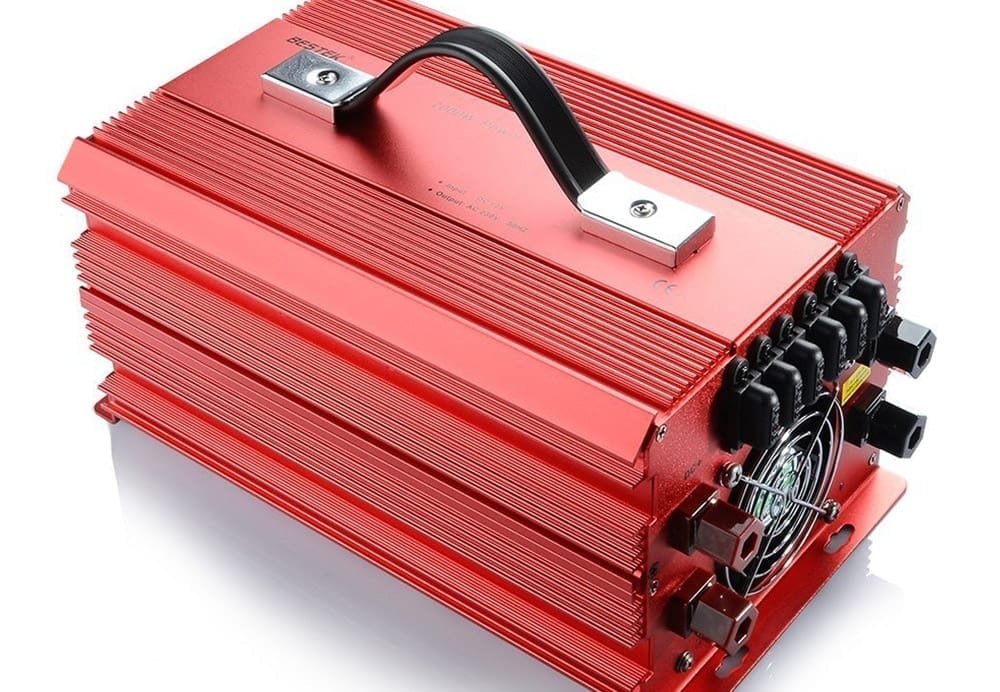
I bought a bestek 2000 watt power lnverter. I have a ford f350 diesal. 2 batteries , do i run the cables to each of the batteries ?